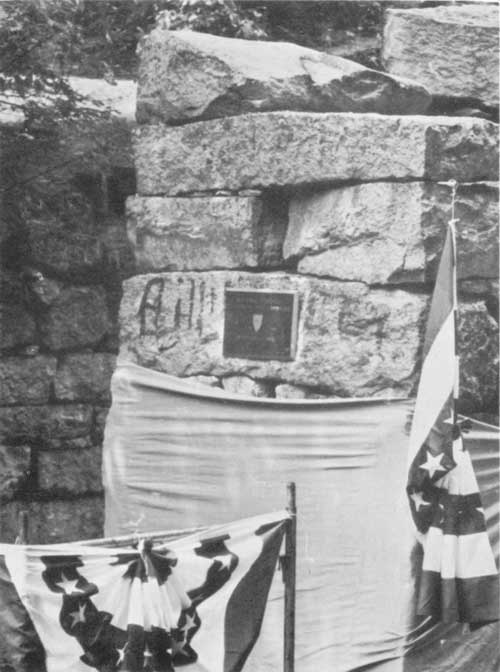

Published by the Middlesex Canal Association
Billerica, Massachusetts
Vol. 5, No. 3 November, 1967
POSTPONED ANNUAL MEETING
Notice is given that the annual meeting of the Middlesex Canal Association will take place on Sunday evening, November 19, 1967 at 7:30 P.M. at the Unitarian Church in Billerica Center.
Instead of a guest speaker, the program will consist of a “photo session,” at which members and guests are urged to bring their photos and slides of the Middlesex and other canals for display. Projectors and screens will be on hand.
After the election of officers and directors, there will be a brief business meeting.
The directors will propose an amendment to the by-laws, changing the date of the annual meeting from the first Saturday in October to the last Saturday in April. The purpose of this change is to avoid conflicts with the annual meeting of the New York Canal Society and also with the annual A.M.C. hike. This will permit us to stress the annual canal walk in the fall as one of our regular activities.
A CHRISTMAS REMINDER
It is not too early to start thinking of Christmas. Many of our friends are planning to use the canal notepaper as Christmas cards or to give them as gifts. Why don’t you consider doing the same?
They are available in sets of 20 cards and envelopes for $1.50 (plus 5¢ tax) or 40 for $2.50 (plus 8¢ tax). On mail orders, add 25¢ for packing and mailing. Address: P.O. Box 333, Billerica, Mass.
A REPORT ON THE AUGUST MEET
On August 4, 1967, the vanguard of almost 200 canallers started arriving at the Holiday Inn in Tewksbury, Mass., site of what we hope was the first annual interstate canal meet. On Friday evening, the out-of-state visitors (who greatly out-numbered local members of the Middlesex Canal Association) visited our exhibit at the Inn and the Lowell Historical Society exhibit of Locks and Canals pictures at the Whistler Birthplace in Lowell. They also had a chance to meet and question several Middlesex Canal “experts” at the Inn.
The next morning the entire group left in four buses for a tour of the Canal, starting from Medford and stopping at the Mystic Lakes in Winchester.
A luncheon al fresco was enjoyed at the Rumford House in Woburn.
In the afternoon stops were made in Wilmington and Billerica, where the National Historic Civil Engineering Landmark plaque awarded by the A.S.C.E. was dedicated at the Shawsheen Aqueduct. The towns of Billerica and Wilmington were represented by members of their boards of Selectmen; and the America Society of Civil Engineers, its New England Section, and the Billerica Historical Society (owner of the Aqueduct) also sent representatives. The Charlestown Minutemen furnished drum rolls and volleys and the Tewksbury Orbiteers band played background music. Troop 55, B.S.A. of Billerica supplied several scouts who acted as guides throughout the day.

The Plaque in place.
The final stop of the tour was in the Chelmsford Cemetery where the group visited the old toll house from Middlesex Village and enjoyed refreshments served by the Chelmsford Historical Society.
On Saturday evening, a capacity crowd enjoyed a banquet at the Holiday Inn. Invited guests and speakers included Dr. Richard W. Hale, acting chairman of the Massachusetts Historical Commission, representatives of the State Department of Natural Resources and of the Division of Tourism of the State Department of Commerce, Mr. Earle T. Andrews, president of A.S.C.E. After the dinner Fred Lawson showed our famous glass slides of canal scenes.
Delegations from Pennsylvania, and Ohio, as well as New York State, represented their canal societies, and the hope was expressed by many that the interstate meet would become an annual event.
Thanks to the enthusiastic support of many workers, the event was a huge success; the Board of Directors expresses its sincere thanks to all participants.
ANNUAL DUES
Dues are now payable. It will help to replenish the Treasury from the ravages of the August meeting, if all proprietors and members will mail their dues or pay them in person at the annual meeting, in order to save the Association the high cost of mailings.
EARLY HISTORY OF THE LOCKS AND CANALS CORPORATION
by Joseph V. Kopycinski
This background story of the Locks and Canals in Lowell was prepared for the August meeting and is reprinted here for the benefit of those members who did not attend. The author is the Librarian of Lowell Technological Institute and custodian of its collection of Locks and Canals material. - Ed.
The forest-covered shores of the Merrimack gave rise in the 18th century to the rafting of logs downriver to Newburyport for the ship-building industry and for shipment to other ports. However, the Pawtucket Falls and the rapids below made an overland journey necessary. To overcome this obstacle, a canal was proposed and planned around the falls. An act was passed on June 27, 1792 incorporating a group of prominent residents into “a body politic and corporate forever, by the name of the Proprietors of Locks and Canals on Merrimack River.”
The Pawtucket Canal was “cut on the side of Chelmsford beginning near the ‘Great Landing Place’ thence running to ‘Lily Pond’ from thence by ‘Speen’s Brook’ to the Concord River.” Four sets of locks were involved - the Guard Locks (at Broadway), the Minx Locks (near Joan Fabrics), the Swamp Locks (just below the Thorndike Street bridge) and the Concord River Locks (at the rear of the old Rex or Prescott Mill Property on East Merrimack Street). A footbridge passes directly over the latter and permits an excellent view of the lock construction.
The canal was completed in 1797 and was the first in the country. But the opening ceremonies would today be a press agent’s nightmare. As the first boat passed through the first lock, the sides gave way and officials, passengers and spectators found themselves in the water. Fortunately, no lives were lost and the canal was put into use. But even before the canal was opened, another nearby construction project, the Middlesex Canal was sounding the death knell for the fledgling waterway. The Middlesex Canal soon found itself in the same position with the construction of the Boston and Lowell Railroad.
The failure of the Pawtucket Canal caused a downward spiral in the value of the shares of the canal company and set the stage for a takeover by the manufacturing interests to be used for a purpose other than that for which it was constructed, but one which gave birth to a giant textile complex and a city. But there was a time span of twenty-three years before such a use was found for this canal. In 1821, one of the directors of the canal, Thomas Clark in contact with the officials of the Waltham Co. purchased the five hundred shares of the canal company. He then came to the area and purchased the farms upon which the city of Lowell was built. The heart of the present city was obtained for about $100,000.
In February of 1832, the group that had made the purchase was incorporated as the Merrimack Manufacturing Company. The construction of the Merrimack Canal and the mill buildings came in short order. It was at this time (January 1825) that the old charter of the Locks and Canals was re-activated and amended by the legislature to allow this company to purchase and hold all of the real estate of the Merrimack Manufacturing Company. They were also allowed to purchase other real estate in Chelmsford, Dracut and Tewksbury not to exceed $100,000 in value exclusive of improvements and were authorized to sell or lease land and water power.
The mill town was soon booming with new industry. In 1828, the Appleton and Lowell companies came into being. Another canal, the Western was constructed in 1831-32 and such large companies as the Suffolk, Tremont, Lawrence and Middlesex came into existence. Another canal in 1835 paved the way for the Boott Mills. A year later, the town became a city, to be later known as “The Spindle City” because of its mammoth textile complex. Soon the Massachusetts and Prescott Companies joined the others. At this stage, the Locks and Canals Company was in itself a large enterprise. They did far more than supply water power to the manufacturing concerns. They manufactured machinery, railroad engines and cars, and built complete mills. They had the largest shop in the country. Their employees included from 500 to 1200 laborers. They manufactured 1225 tons of wrought and cast iron per year and consumed 15,000 bushels of charcoal, 400 tons of hard coal, 200 cords of wood and 2,300 gallons of oil. They had enough material on hand to build and refurbish a mill and equip it with machinery for 5,000 spindles within four months.
In 1847, the Locks and Canals built the giant Northern Canal and purchased and improved the headwaters of the Merrimack River so as to more than double the water power available. At this time, James B. Francis was chief engineer of the company, a position he had held since George Whistler, the father of the famous painter, retired from the post. His experiments in hydraulics, especially covering the use of water power for the cotton mills, led to the rise of Lowell as an industrial center. He published his results in “The Lowell Hydraulic Experiment” in 1855. He, together with Uriah A. Boyden, developed a new type of turbine which now bears his name. He developed hydraulic lifts for canals, a system of factory fire protection and became an authority on dam construction. In 1875, he supervised the reconstruction of the Pawtucket Dam.
Today, the 175-year old company still furnishes a small amount of water power to the rapidly dwindling collection of old textile mill buildings. But the wrecking boom is coming dangerously close to obliterating the remains of an amazing industrial lay-out. All future city redevelopment should be undertaken with the thought of preserving for posterity this slice of industrial Americana.
BOOK REVIEW
“The Limner’s Daughter” by Mary Stetson Clarke
The Viking Press - $3.95
We are told that Mary Stetson Clarke writes historical novels primarily for young people. However, “The Limner’s Daughter” will interest and delight any age, particularly those acquainted with Middlesex County, canal buffs, and anyone who enjoys a good tale.
Amity Lyte, the heroine of the story, is just that. At sixteen, she was struggling to support her ailing father, a former portrait painter, and her young brother by working in a sail factory in Boston. Just as she was about to despair, an invitation arrived from an unknown great-aunt, offering a home to the three of them. The aunt lives in Woburn and Amity is told that the “only civilized way to travel from Boston to Woburn is by the Middlesex Canal.” The description of this trip affords the reader a picturesque tour of the Canal as it was at the peak of its career during the early 1800’s.
In Woburn, Amity finds new friends, new hope and more adversity. She discovers, too, why her father was so reluctant to make the trip and the animosity toward Tories (and especially toward Count Rumford) which still exists three decades after the Revolution.
Through his nephew, Amity is introduced to the great Colonel Loammi Baldwin. It is because of the Baldwin family and Amity’s determination that the story is brought to a happy ending.
One is impressed with the author’s extensive research and ease with which historical facts and characters are woven into the story. It is only fitting that Mary Stetson Clarke be a member of the Middlesex Canal Association, and it is heartily recommended that her book be on the reading and gift list of every other member.